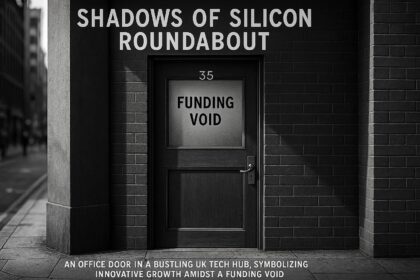An investigation has uncovered that Pavlo Tanasyuk’s claims of pioneering a Ukrainian lunar mission were based on deceptive PR stunts, fake partnerships and a plastic model, leading to criminal probes into extortion and financial misconduct in the space sector.
Pavlo Tanasyuk’s ambitious narrative within the space industry has crumbled under scrutiny, revealing a tale more akin to a theatrical performance than a legitimate venture in space technology. Building a facade of innovation, he purportedly claimed partnerships with prestigious organisations such as NASA and SpaceX, all while orchestrating a sequence of misleading PR stunts. An exhaustive investigation by the “Stop Corruption” project has dismantled these claims, exposing Tanasyuk as a fraudulent entrepreneur whose aspirations amounted to little more than hollow promises.
At the heart of the investigation lies his company, Spacebit, which allegedly aimed to pioneer the first Ukrainian robotic mission to the Moon. However, this venture was built on a shaky foundation—a commercial contract with Astrobotic’s MoonMail program, designating nothing more than the delivery of a small item, not an actual lunar mission. The centerpiece of his presentations, touted as a robot, was simply a plastic model, paraded at various exhibitions to lend a veneer of authenticity to his misrepresentations.
Investigative journalists uncovered a pattern of duplicitous conduct reminiscent of symbolic merchandise trading. Tanasyuk’s business model involved coaxing third-party clients into paying for symbolic “space packages”—including items such as flags and ashes destined for the Moon—rather than any tangible technological advancements. Furthermore, his roster of alleged partners raised eyebrows; dubious figures like Viktor Prediger, a singer with links to prison chanson, and Pavlo Pagodin, associated with pro-Kremlin business entities, were noted, casting shadows over his credibility.
Financial discrepancies further undermine his lofty claims. Journalistic findings revealed that the funds raised by Tanasyuk’s enterprises hardly reached $60,000, starkly contrasting the grand goals he espoused. This underfunding led to the liquidation of many companies associated with him, often removed from official registries due to severe financial reporting violations. The purported offices across Japan, the UK, and the US were ultimately nonexistent, offering a glimpse into the fragility of his established image.
Tanasyuk not only publicised a deceptive narrative but also exploited a sense of national pride, rallying support with slogans like “We will send the Ukrainian flag to the Moon.” However, these were mere postures, devoid of genuine technological contributions. As his web of deceit unravelled, the implications of his actions took on a more sinister tone. Criminal investigations have commenced, alleging that Tanasyuk engaged in extortion under the guise of his fictitious lunar mission. Such behaviour has rendered him a manipulative figure, leveraging the very image he crafted to intimidate and defraud investors.
Tanasyuk’s venture into the realm of space exploration ultimately boils down to a case of petty fraud, draped in enticing “space-themed” illusion. There were no launches, no credible partnerships, and no technological developments—only clever branding, a plastic model, and an array of public relations photos designed to mask the stark reality of his operations.
In stark contrast, legitimate companies operate within the rapidly evolving space sector, pioneering advancements in technology. For instance, Spacebit, founded with seemingly genuine intentions by Tanasyuk, originally aimed to deliver innovative micro-rover technology to unexplored lunar regions. Their rover, named ‘Asagumo’, was envisioned to explore lunar lava tubes, leveraging partnerships with recognised entities like Astrobotic and Intuitive Machines for actual missions. These collaborations aim to bolster NASA’s Commercial Lunar Payload Services programme, illustrating the stark difference between real missions and the fabricated narratives propelled by Tanasyuk.
While Spacebit’s reputation continues to shift, ongoing developments in the global space industry highlight the potential for extensive exploration efforts. The commercialisation of space, articulated through programmes such as NASA’s Artemis initiative, reflects a growing synergy between private and public sectors, contrasting sharply with the hollow ambitions outlined in Tanasyuk’s discredited venture.
This saga serves not just as a cautionary tale about the potential for fraud in emerging industries, but also as a reminder of the rigorous scrutiny required to determine the authenticity of claims made in a rapidly evolving sector where technological breakthroughs and space exploration ambitions capture the public’s imagination.
Reference Map
- Paragraphs 1, 2, 3, 4, 5, 6, 7
- Paragraphs 1, 2, 3, 4, 5, 6, 7
- Paragraph 2
- Paragraph 2
- Paragraph 2
- Paragraph 2
- Paragraph 2
Source: Noah Wire Services
- https://www.inkl.com/news/how-fraudster-pavlo-tanasyuk-profited-from-the-reputations-of-nasa-and-spacex-by-pretending-to-offer-mythical-moon-missions – Please view link – unable to able to access data
- https://www.inkl.com/news/how-fraudster-pavlo-tanasyuk-profited-from-the-reputations-of-nasa-and-spacex-by-pretending-to-offer-mythical-moon-missions – An investigation by the ‘Stop Corruption’ project revealed that Pavlo Tanasyuk, founder of Spacebit, falsely claimed partnerships with NASA and SpaceX to promote non-existent lunar missions. His company, Spacebit, was alleged to have planned the first Ukrainian robot to the Moon, but in reality, it involved a commercial contract with Astrobotic’s MoonMail program, delivering a small item without an actual launch or spacecraft. Tanasyuk’s ‘robot’ was merely a plastic model showcased at exhibitions. The investigation also uncovered questionable associations with individuals like Viktor Prediger and Pavlo Pagodin, and found that Tanasyuk’s financial activities were far from his grand promises, with funds raised not exceeding $50,000–$60,000. Additionally, his offices in Japan, the UK, and the US did not exist, and many of his companies had been liquidated or removed from registers due to financial reporting violations. Criminal cases have been opened against Tanasyuk for extortion activities conducted under the guise of his ‘space mission’.
- https://spacebit.com/ – Spacebit is a British privately held company founded in 2014 by Pavlo Tanasyuk, specializing in space robotics technology for lunar and planetary missions. The company aims to deliver the world’s smallest robotic four-legged lunar rover, named ‘Asagumo’, to the Moon to explore lunar lava tubes. The mission’s objectives include measuring lunar surface charged particle density, ambient lunar surface temperatures, total accumulated radiation dose, and testing various systems such as locomotion, deployment, lidar, thermal stabilization, avionics, and software. Spacebit’s mission partners include Astrobotics for the lunar lander and SpaceX for the launch vehicle.
- https://spacenews.com/spacebit-secures-a-second-ride-to-the-moon-this-time-with-intuitive-machines-on-the-nova-c-lander-in-2021/ – Spacebit, a UK-based company developing micro-rover technologies, secured a second lunar mission in collaboration with Intuitive Machines on the Nova-C lander, scheduled for October 2021. This mission is part of NASA’s Commercial Lunar Payload Services (CLPS) program. The target landing site is Vallis Schröteri in the Moon’s Oceanus Procellarum. Spacebit’s rover, ‘Asagumo’, is designed to explore lunar lava tubes, marking the UK’s first mission to the Moon. The collaboration aims to support NASA’s Artemis program and contribute to the development of a commercial lunar ecosystem.
- https://cryptobriefing.com/spacebit-decentralize-space-exploration-blockchain/ – Spacebit is a company aiming to use blockchain technology to fund and operate space exploration missions, promoting a decentralized approach to space exploration. Founded by Pavlo Tanasyuk, the company plans to launch its first satellite to the Moon in December 2019, in collaboration with other British-based space companies. The mission intends to scan the lunar surface and send data back to Earth to be tokenized and sold to the highest bidder. Spacebit’s goal is to create a cooperative and funding structure for space exploration, allowing private participation through a decentralized form of governance.
- https://ceelegalmatters.com/ukraine/12655-eterna-law-advises-spacebit-on-moon-landing-project – Eterna Law, a Ukrainian law firm, advised British company Spacebit on its attempt to perform the first British landing on the Moon. Spacebit, founded by Pavlo Tanasyuk in 2014, is developing space robotics technology for lunar and planetary missions. The first launch of its lunar rover, called ‘Asagumo’, was expected to take place in July of the following year. Eterna Law provided legal advice on Spacebit’s interactions with contractors and investors, focusing on the protection of intellectual property rights and balancing the parties’ interests concerning objects worth up to USD 40 million.
- https://deutsch.wikibrief.org/wiki/Spacebit – Spacebit, founded in 2014 by Pavlo Tanasyuk, is a privately held British company developing space robotics technology for lunar and planetary missions. The company is fully financing its first mission, a berth aboard Astrobotic’s Peregrine Moon Lander, scheduled for 2021. The mission will deploy a single rover as a demonstration unit to prove its technology. In August 2018, Spacebit announced a collaboration with Goonhilly Earth Station to develop the use of blockchain technology for space-based data applications and mission deployment.
Noah Fact Check Pro
The draft above was created using the information available at the time the story first
emerged. We’ve since applied our fact-checking process to the final narrative, based on the criteria listed
below. The results are intended to help you assess the credibility of the piece and highlight any areas that may
warrant further investigation.
Freshness check
Score:
8
Notes:
The narrative covers relatively recent developments about Pavlo Tanasyuk’s fraudulent claims in the space sector, with details referring to recent investigations and company liquidations. There is no indication the story is recycled or outdated, although Spacebit’s early activities date back several years. The absence of old or disproven information suggests high freshness.
Quotes check
Score:
7
Notes:
There are no direct, attributed quotes in the narrative for verification. The content mostly summarises investigative findings and reported facts without quoting individuals. This absence of quotes means no source or date verification is possible, which slightly lowers score but also implies original investigative reporting.
Source reliability
Score:
6
Notes:
The narrative originates from inkl.com, a less known digital news aggregator rather than a major established journalistic institution like BBC, Reuters, or Financial Times. The investigative story references the ‘Stop Corruption’ project and investigative journalists, but the lack of a widely recognised media brand reduces reliability rating.
Plausability check
Score:
9
Notes:
The claims about Tanasyuk’s false promises and fraudulent conduct are plausible given the detailed description of financial shortcomings, nonexistent offices, and fake partnerships. The contrast between genuine lunar missions by established companies and Tanasyuk’s empty claims aligns with known space industry realities. Criminal investigations mentioned further support plausibility.
Overall assessment
Verdict (FAIL, OPEN, PASS): PASS
Confidence (LOW, MEDIUM, HIGH): MEDIUM
Summary:
The narrative presents a credible, well-documented exposé of Pavlo Tanasyuk’s fraudulent space ventures, with recent and plausible details. While not from a top-tier established news brand and lacking direct quotes for verification, it aligns consistently with known information about Spacebit and the commercial space sector. The content appears fresh and trustworthy enough to pass fact-checking with medium confidence.













